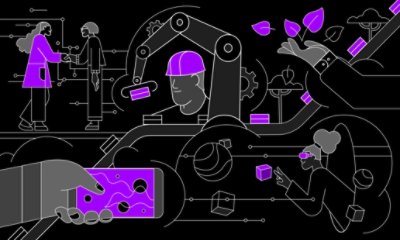Perspective
The five key forces of change
5-MINUTE READ
Perspective
5-MINUTE READ
Today’s exponential pace of disruption means companies have now entered a period of positive unprecedented change. Rapid advancements in emerging technologies, including Quantum computing, Generative AI, Web3, robotics, 5G and the Metaverse Continuum, are transforming industries, enabling new business models and reshaping traditional ways of working and living.
Our Global Disruption Index—a composite measure that covers economic, social, geopolitical, climate, consumer and technology change—shows that levels of disruption increased by 200% from 2017 to 2022. In comparison, the Index rose by only 4% from 2011 to 2016. As such, companies now face a permanent state of change at a pace never seen before.
Each of these five forces is distinct and reflects profound change across the business. They are also deeply intertwined. One alone is not enough. In combination, companies can use them to dramatically change the ways they work, engage and transact—and transform, accelerate growth and thrive over the next decade.
Total Enterprise Reinvention is a deliberate strategy that aims to set a new performance frontier for companies and the industries in which they operate. Centered around a strong digital core, it helps organizations accelerate growth and optimize operations by transforming every part of the business through technology, data, artificial intelligence (AI) and new ways of working. While digital transformation can change individual elements within a business, Total Enterprise Reinvention fundamentally changes the entire business. It connects what’s happening at the company with what’s happening in the world and fosters new skills. In this way, it engages a deeper understanding of technology, change management, communication and collaboration.
Organizations that make the most of Total Enterprise Reinvention (known as “Reinventors”) gain a competitive advantage. Our research shows they generate 10% higher incremental revenue growth, 13% greater cost reduction and 17% higher balance sheet improvements. It’s more than just the bottom line, however; 76% of Reinventors, say that setting non-financial targets is very important to their success. To this end, they score 11% higher on innovation, 32% better on sustainability and 31% better on experience for customers, suppliers and employees.


Empowering people is an essential part of any transformation. In other words, there is no business strategy without a talent strategy. As CEOs look for new paths to growth, our research shows companies can gain an 11% premium on productivity—the ultimate driver of revenue and profitability—by unlocking the powerful combination of data, tech and people.
To maximize this combination, companies do three things:
Companies that use people-related data and insights to connect talent more directly to business outcomes are able to fuel strategic automation and transform employee experiences. Through AI-powered insights, they understand which skills the organization needs and how to attract people who have them. They build digital ecosystems that drive productivity and collaboration internally and revamp the recruitment and hiring processes to find untapped sources of new talent externally.
Tech-driven strategies and predictive insights help companies identify workers who can shift their skills or reskill to meet new needs. They invest in skills development to meet growth objectives and build the infrastructure to deliver the right capabilities at the right time across the business, even as needs change.
Organizations that prioritize people at every level and enable boundaryless collaboration across the enterprise do this most effectively by empowering the Chief Human Resources Officer to see growth opportunities.


The digital revolution changed how people live and work; now, sustainability is proving equally transformative. Sustainability includes a full spectrum of environmental, social and governance (ESG) issues, such as transitioning to a zero-carbon economy, supporting human rights and embracing inclusion and diversity.
Companies that focus on ESG issues perform better financially, generating up to 2.6 times more value for shareholders than their peers. And CEOs we surveyed say that positioning sustainability as a core part of the business model is a key way to protect against instability and build a foundation of security, growth and resilience. They are taking steps—from accelerating net-zero transitions to building more efficient value chains—to embed sustainability into their operations.
The success of these efforts, however, relies on stakeholders understanding the connection between values and profitability. So organizations need to be built on Sustainability DNA to deliver the social impact and financial performance that foster trust among all stakeholders. By closing consensus gaps and taking action, businesses can activate sustainability as one of the five key forces of change.


The lines between the physical and digital worlds are blurring—and what happens next will define a generation. The Metaverse Continuum is a fast-evolving spectrum of technologically enhanced experiences, realities and business models. From digital layers on the real world to completely virtual environments, the metaverse offers endless opportunities—and, at this nascent stage, few limitations.
It’s easy to get lost in the buzzwords and hype, but the impact of these immersive technologies is very real. Smart factories are integrating digital twins into their operations, to improve safety, efficiency, and environmental impact. Companies are using virtual training sessions to welcome new employees and connect remote workers. And new opportunities for consumer spaces that allow socializing, entertainment, information sharing and learning are proliferating across these new worlds. Executives expect 4.2% of their revenues to come from the metaverse in the next three years—a value of $1 trillion.
Major players are investing in the technology and skills it will take to power this digital experiment. But it will be creative, people-driven experiences (not just the technology itself) that drive success. To harness the metaverse as a force for change, companies need to see its human potential. That means building trust among its users and ensuring this new, life-changing technology doesn’t outpace society’s best intentions. Organizations must aim to create a Responsible Metaverse in which trusted technologies and human-centric experiences deliver a more sustainable, diverse and inclusive future.


New forms of technological innovation—everything from synthetic biology and smart materials to quantum computing and the space industry—are stretching imagination and pushing the boundaries of what companies can achieve.
Cloud computing is allowing companies to operate with ever-greater speed and agility. Industry X is using data and technologies such as AR/VR, 5G, robotics and digital twins to change the world of engineering and manufacturing. And Generative AI is showing its potential to upend nearly every aspect of any enterprise. With technology evolving at exponential rates, change isn’t just inevitable, it’s a continuous force.
Incremental steps are no longer enough to keep up. Companies need to use technology to identify new ways to reach consumers and build enterprise resilience. To create breakthrough innovations and lead in the years to come, they will have to capitalize on these advances to continuously transform and grow. That means viewing technological innovation as a strategic imperative that guides decisions enterprise-wide.
Every business must embrace disruption to remain relevant in the future. By harnessing the Ongoing Technology Revolution as one of the five key forces of change, companies can keep up with innovation today—and define what comes next.


We live in two parallel realities, one of atoms (physical) and one of bits (digital). The next big business transformation will seamlessly combine both. In this shared reality, we will launch innovative products, a new era of scientific research and more.